Charting Jesamine
Jesamine was released on 31st May 1968 but did not enter the UK Top 50 until 20th August, reaching No 2 in November. Ironically, it was kept off the top spot by that year’s Opportunity Knocks winner, Mary Hopkin.
Altogether ‘Jesamine’ spent eighteen weeks in the Top 50 and was the thirteenth best selling single of the year, outstripping ‘Jumpin’ Jack Flash’, Crazy World of Arthur Brown’s ‘Fire’ and Joe Cocker’s ‘With a Little Help from My Friends’.
The single enjoyed very good airplay on Radio 1 which perhaps explains its  slow-burning success.
slow-burning success.
When it emerged also as a European hit, ‘Jesamine’ (often spelt ‘Jezamine’ on European releases) was released in the US, appearing as ‘Jesamine (A Butterfly Child)’ but wasn’t a hit.
Marty Wilde covered his own composition under the name of Shannon, scoring only a number 104 in the US charts in 1969. In this live version, he sings in an almost semi-crooning style at times over harpsichord, flutes and strings but his version lacks the drive of The Casuals with contributions from the band.
Embed from Getty Images
The B-side, lest I forget, was Greenaway-Cook’s fine I’ve Got Something Too, a sweeping, slow building ballad with a shimmering introduction.
Imagining Jesamine
The band relocated fully to the UK to promote ‘Jesamine’ once it was clear the single was becoming a Top 20 hit. However, there appears to be no Top of the Pops footage remaining of ‘Jesamine’. The band would have also performed their single on other shows of the time such as Southern TV’s Time for Blackburn so it’s possible footage may yet emerge.
 The only known TV performance footage is from German TV’s Beat Club in October 1968, in black and white and so laden with overlapping images and striking lighting that the faces of the band are barely visible.
The only known TV performance footage is from German TV’s Beat Club in October 1968, in black and white and so laden with overlapping images and striking lighting that the faces of the band are barely visible.
Records show that between August 1968 and the end of 1969, The Casuals recorded no less than 36 sessions for BBC radio so listeners would have had ample opportunity to sample the diversity of the group beyond their major hit.
One of these sessions is captured on Shapes & Sounds 2: Shades of Deepest Purple from the BBC archives 1967-1971 [Top Sounds, 2008, TSSCD 003].
We get a chance to hear how The Casuals handled Jesamine as a live band, whilst two further tracks – Midnight Confessions (written by Lou Josie and covered by The Grass Roots) and Take Me For a Little While (written by Trade Martin and performed earlier by Evie Sands) – show them as beat group, live attraction and versatile professional outfit. John Tebb’s voice remains terrific on the uptempo material. A further version of ‘Take Me For a Little While’ was recorded as part of the Hour World sessions but didn’t make it  onto the album.
onto the album.
On ‘Jesamine’ it sounds as if the vocals might be shared, with Howard Newcomb taking over at ‘When Jesamine stays…’ although I could be wrong here. Certainly there is a differentiation which is not on the single.
Loving Jesamine
Back in 1968, Barry Gibb said ‘Jesamine’ was “about the best record of the year”.
Singapore group The Quests covered the song in 1970 with much charm and lovely organ and echo overload – listen here
Paul Weller loved the song so much he named his child after it (judging from comments on Youtube and elsewhere he wasn’t the only one). It is track six on a 2003 covers’ compilation of some of his favourites, Under the Influence.
The song seems to have lasting appeal judging by many fond comments and recollections online. I get the impression that people who don’t much like 60s music give it a try and find they are enchanted too.
It seems as if, over the years, Jesamine has gathered even more of a sense of fragile beauty unto herself. The song inspires recollections of childhood’s sun dappled days in the 60s or simply of carefree youth – more innocent times in every sense.
There is a minor scene in episode one of The Tyrant King (Thames Television’s ‘swinging London’ children’s adventure series) in which the children are in a bedroom and ‘Jesamine’ is heard playing in the background. With The Tyrant King airing in October 1968, this scene would have been filmed as the single gained airplay in the summer or early autumn. The children pay the music little attention but it hardly seems to matter. Indeed it’s the incidental way in which the song is experienced which is so poignant because this is how ‘Jesamine’ would have been heard by millions at the time, as background, yes, but also as a kind of permeating loveliness whose piquancy is only fully realised when momentarily recaptured by us as adults viewing this scene or hearing the song many years later.
As pop has become harder, shinier, more industrial, more unrelenting, Jesamine represents a kind of vanished spirit of innocence, embodying its own, and our own, ephemerality. It surely ranks as one of the finest and most memorable No 2 hits of all time.
The butterfly child lives on.
Love’s In Control: The Casuals’ Jesamine
The Casuals on Beat Club
When Jesamine Goes: the singles: 1968/69
Previous posts on The Casuals
The Casuals: beyond Jesamine
The Casuals: before Jesamine: 1961- mid 1968
Jesamine Part 1

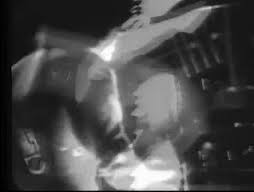

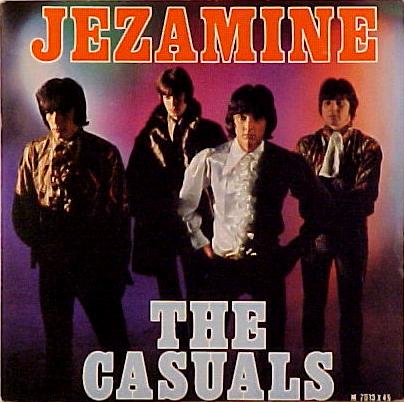
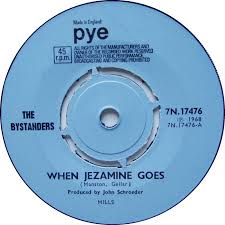 Jesamine has an interesting history. It was covered firstly by The Bystanders as When Jezamine Goes. Although released only six months prior to The Casuals’ version, its primitivism gives it the feel of a 1966/early 1967 single.
Jesamine has an interesting history. It was covered firstly by The Bystanders as When Jezamine Goes. Although released only six months prior to The Casuals’ version, its primitivism gives it the feel of a 1966/early 1967 single.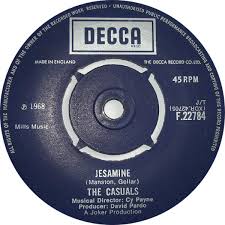 than an awkward pause in The Bystanders’ version. There are delightful, unexpected but just right plucked strings, curling woodwind and that drowsy single acoustic guitar strum before the harmonies return.
than an awkward pause in The Bystanders’ version. There are delightful, unexpected but just right plucked strings, curling woodwind and that drowsy single acoustic guitar strum before the harmonies return.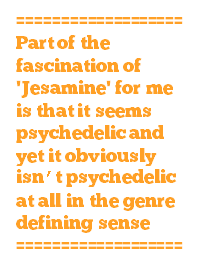 Jesasmine?’, setting us up for the song.
Jesasmine?’, setting us up for the song.